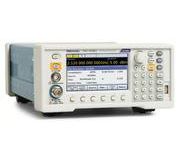PRODUCT
고객님께 적합하고 효율적인 최선의 솔루션을 제안하겠습니다.
tektronix>>신호발생기>>TSG4100A
The TSG4100A Series RF Vector Signal Generator offers mid-range performance and up to 200 MHz modulation bandwidth at an entry-level RF signal generator price. They use a new technique to provide spurious free outputs with low phase noise (-113 dBc/Hz at 20 kHz offset from 1 GHz carrier) and extraordinary frequency resolution (1 μHz at any frequency). The TSG4100A Series comes standard with analog modulation. Convenient, in-field software upgrades allow for easy transition from analog to more advanced vector and digital modulation capabilities, providing the most flexible configuration and best CAPEX protection. These instruments complement other leading mid-range RF test solutions from Tektronix, such as the USB-based RSA306 Spectrum Analyzer and MDO4000B and MDO3000 Mixed Domain Oscilloscopes.
The TSG4100A Series instruments use an ovenized SC-cut oscillator (TSG410xA-M00 or E1 models) time-base, providing a 100 X improvement in stability (and a 100 X reduction in the in-close phase noise) compared to instruments that use a TCXO time-base.
Key features
- Analog and vector/digital signal generation capabilities
- Dual baseband ARB generators
- Analog modulation standard
- Soft key upgrade to vector/digital modulation at very low cost
- Digital modulation applications for GSM, EDGE, W-CDMA, APCO-25, DECT, NADC, PDC, and TETRA
- USB, GPIB, RS-232, and LAN interfaces
- 12 pounds (5.6 kg)
- 2U high and half standard rack width
Key performance specifications
- True DC to 2 GHz, 4 GHz or 6 GHz to support both analog and vector/digital signal generation
- Typical ≤±0.30 dB amplitude accuracy (0 dBm CW signal at 22 ºC) from 10 MHz to 6 GHz
- I/Q modulation inputs (400 MHz RF bandwidth)
- ASK, FSK, MSK, PSK, QAM, VSB, and custom I/Q
Analog modulation
The Tektronix TSG4100A Series RF Vector Signal Generators offer a wide variety of modulation capabilities. Modes include amplitude modulation (AM), frequency modulation (FM), phase modulation (ΦM), and pulse modulation. There is an internal modulation source as well as an external modulation input. The internal modulation source produces sine, ramp, saw, square, and noise waveforms. An external modulation signal may be applied to the rear panel modulation input. The internal modulation generator is available as an output on the rear panel.
Vector modulation
The TSG4100A Series builds on this performance by adding full support for vector signal modulation on RF carriers between 400 MHz and 6.0 GHz. It features a dual arbitrary waveform generator operating at 125 MHz for baseband signal generation. The generator has built-in support for the most common vector modulation schemes: ASK, QPSK, DQPSK, π/4 DQPSK, 8PSK, FSK, CPM, QAM (4 to 256), 8VSB, and 16VSB. It also includes built-in support for all the standard pulse shaping filters used in digital communications: raised cosine, root-raised cosine, Gaussian, rectangular, triangular, and more. Lastly, it provides direct support for the controlled injection of additive white Gaussian noise (AWGN) into the signal path.
Internal baseband generators
Using a novel architecture for I/Q modulation, the TSG4100A Series provides quick, user-friendly waveform generation. The baseband generator supports the playback of pure digital data. It automatically maps digital symbols into a selected I/Q constellation at symbol rates of up to 6 MHz and passes the result through the selected pulse shaping filter to generate a final waveform updated in real time at 125 MHz. This baseband signal is then modulated onto an RF carrier using standard IQ modulation techniques.
Digital communications protocols (GSM, GSM EDGE, W-CDMA, APCO-25, DECT, NADC, PDC, and TETRA) quickly configure the signal generator to the correct modulation type, symbol data rates, TDMA duty cycles, and digital waveform filters. The preset protocols also configure the rear-panel TDMA, START of FRAME, and SYMBOL CLOCK digital outputs. The baseband generators can be configured for these protocols without the use of external computers or third party software.
The I/Q waveforms are computed in real time. Symbols are mapped to constellations, digitally filtered, and up-sampled to 125 Msps to drive the I/Q modulator via dual 14-bit DACs. The symbols can be a fixed pattern, PRBS data from an internal source, or come from a downloaded user list of up to 16 Mbits.
The constellation mapping can be modified by the user. Digital filters include raised cosine, root raised cosine, Gaussian, rectangular, linear, sinc, and user-defined FIR.
External IQ modulation
The rear-panel BNC I/Q modulation inputs and outputs enable arbitrary vector modulation via an external source. The external signal path supports maximally 400 MHz of RF bandwidth with a full scale range of ±0.5 V and a 50 Ω input impedance.
Power vs. frequency
All TSG4100A Series models have cascaded stages of amplifiers and digital attenuators to drive the RF output. Five stages can provide up to +25 dB of gain to -130 dB of attenuation in 156 digitally controlled steps. During factory calibration, the output power is measured at 32 frequencies per octave for each of the 156 attenuator steps to populate a memory matrix with about 40,000 elements. When set to a particular frequency and power, the instrument interpolates between these matrix elements to determine the best attenuator setting. An analog attenuator is used to provide 0.01 dB resolution between matrix elements and to compensate for residual thermal effects.
OCXO time-base
These instruments offer an oven-controlled crystal oscillator (OCXO) time-base. The time-base uses a third-overtone
Standard accessories
| Accessory | Description |
|---|---|
| RF cable | 1 meter, N-type to N-type RF cable |
| Documentation CD | All instrument models ship with a CD containing PDF files of user manuals in all available languages. |
| Installation and Safety Instructions | All instrument models ship with a printed Installation and Safety Instructions manual (multi-language: English and Russian). |
| Calibration | Statement of Calibration |
| Power cord | Country specific (see Power cord options) |

